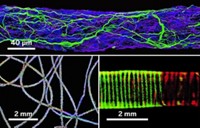Advertisement
Grab your lab coat. Let's get started
Welcome!
Welcome!
Create an account below to get 6 C&EN articles per month, receive newsletters and more - all free.
It seems this is your first time logging in online. Please enter the following information to continue.
As an ACS member you automatically get access to this site. All we need is few more details to create your reading experience.
Not you? Sign in with a different account.
Not you? Sign in with a different account.
ERROR 1
ERROR 1
ERROR 2
ERROR 2
ERROR 2
ERROR 2
ERROR 2
Password and Confirm password must match.
If you have an ACS member number, please enter it here so we can link this account to your membership. (optional)
ERROR 2
ACS values your privacy. By submitting your information, you are gaining access to C&EN and subscribing to our weekly newsletter. We use the information you provide to make your reading experience better, and we will never sell your data to third party members.
Materials
Lipids protect cells
July 24, 2006
| A version of this story appeared in
Volume 84, Issue 30
With their molecular-recognition capabilities, living cells would make excellent sensors, but they must first be integrated into devices. C. Jeffrey Brinker and coworkers at Sandia National Laboratories, the University of New Mexico, and Los Alamos National Laboratory describe a method for incorporating cells into silica nanostructures and extending cell viability (Science 2006, 313, 337). Adapting an approach known as evaporation-induced self-assembly, they include lipids and cells in a mixture with silicic acid. During evaporation of the solvent to give a silica nanostructure, the lipids form a multilayered interface between the cells and the surrounding silica nanostructure. Additionally, the cells develop a pH gradient around themselves, which, the authors believe, switches the silica nanostructure from a hexagonal to a layered phase. The structure withstands drying and low pressure without cracking, protecting the cells and keeping them alive, even under dry conditions, without added buffer. More than half of the incorporated yeast cells were still alive after a month.






Join the conversation
Contact the reporter
Submit a Letter to the Editor for publication
Engage with us on Twitter